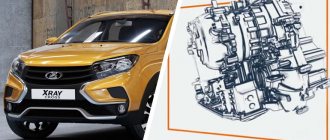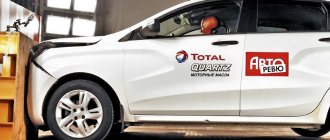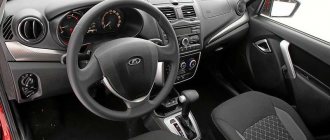Until its release, the Lada X Ray remained a fairly anticipated car for a number of obvious reasons. First of all, modern design, economical and productive engines, as well as the presence of an automatic transmission, combined with an affordable price compared to competitors in this class, have made the Lada XRAY model quite popular and in demand.
At the same time, maximum attention was initially focused on the automatic transmission, transmission type and features. Next, we will look at what the Lada X Rey with automatic transmission is, what kind of automatic transmission is on the X Rey, and also what to look for when choosing the version of the Lada X Rey automatic transmission.
The main differences between VESTA and X RAY
Briefly about each model. Lada Vesta is a sedan, developed from scratch, so a lot of time was spent on design. The model was expected by AvtoVAZ fans, and therefore quickly became popular.
Lada X-Ray is still more of a hatchback body than a crossover, but the issue is debatable. The platform for further development of the model was the Renault Sandero car, so the design took relatively little time. A reliable foundation that has been tested by time has become the strength of XRAY.
Why isn't X-ray a crossover? The lack of all-wheel drive could indicate that the Lada is actually a hatchback, but at the same time, the main difference between the CUV body is the corresponding appearance and high seating position, and all-wheel drive is not always available. What does this mean? That XRAY has both sides, and you have the right to consider it both, because... the question of its body is controversial.
Semi-automatic on Lada X-Ray
After the presentation of the Lada X-Ray concept with a manual gearbox, the question of an alternative to mechanics remained open and was of great interest to potential consumers. The need to develop a transmission option other than a manual transmission was unconditional. This is especially true for residents of megacities, who deal with the phenomenon of traffic jams every day. Changing gears manually using a lever in this driving mode is physically not very convenient.
Drivers were wondering what kind of automatic transmission would be on the X-Ray, and it turned out to be a semi-automatic AMT (auto-manual transmission). During the time that elapsed from the presentation of the Lada at the exhibition to its launch into mass production, AvtoVAZ decided to introduce a semi-automatic robotic gearbox as a second transmission option. This type of transmission is a five-speed gearbox, similar in principle to a manual gearbox, in which the function of disengaging and engaging the clutch with the road is carried out by an electronic control system (which is why it is commonly called a robot).
The gearbox of the Lada X-Ray is developed on the five-speed platform from the VAZ 2180 and has similar technical characteristics. Moreover, the main mechanism of this gearbox was not replaced, but only improved together with the German concern Friedrichshafen.
Model specifications
Lada Vesta can be filled with 92-octane gasoline, but its brother is advised to use 95-gasoline, which is more expensive, considering the price of fuel. Both the sedan and the hatchback have front-wheel drive, the same speed - 4200 rpm. and acquired many auxiliary systems: ABS, ESP, etc.
The difference between Vesta is that it has an enlarged tank - 55 liters, the body has one less door than the hatchback - 4 (X Ray has 5), its average consumption is less, only 6.9 liters, but, unfortunately, only 2 airbags.
The Lada X-Ray has a smaller tank - 50 liters, a higher consumption - 7.2 liters, but it has 4 airbags, including side airbags, which Vesta does not have.
Let's look at the main distinguishing characteristics in more detail below.
You can leave reviews about the Lada Vesta sw Cross here
Dashboard
The X X Ray panel is made, in my opinion, from a not very practical material - rough plastic. Firstly, the appearance is not presentable, as for a car of this level, and secondly, dust and dirt are quite difficult to remove from it. Of course, these are all little things, so to speak, not for everyone.
I liked the design of the car’s instrument panel, but its information content leaves much to be desired. The device's scales are so dim that it is very difficult to read and see them. The situation is saved by turning on the dimensions; it is at this moment that the shield begins to be visible from the inside and becomes quite readable.[lightbox full=”https://ixray.ru/wp-content/uploads/2017/03/IMG0644.jpg”]
There are a few other minor shortcomings that could have been foreseen in the X-Ray car. The lack of a central armrest, a heated steering wheel, and illuminated makeup mirrors are the main disadvantages inside the cabin.
The seats, in principle, can be called comfortable, however, in order to achieve this result you had to work hard with their settings
The spatial characteristics of the rear seats are quite good due to their vertical seating. The appearance of the seats is neat and tidy. French frame adds solidity
Parking becomes much easier and easier thanks to the rear view camera
The xray car interior, in principle, has no serious flaws that will greatly affect the comfort
It would be very good if the trajectory frame was movable. But it will be uncomfortable for the long-legged front passenger, because his leg will rest against the “beard” of the center console. There is an additional storage compartment under the front passenger seat. The presence of two airbags allows you to feel more confident on the road.
To summarize, we can say that driving such a car evokes positive emotions. The basic safety equipment is much higher than that of competitors. Regarding the interior, it is spacious, discreet and laconic. On a scale of ten, you can give it a solid nine for comfort. This rating is due to the fact that there are minor shortcomings in the functions and options of the xRay interior.
Related articles:
All cons x Ray owner reviews
I'm pleased with the excellent noise insulation, which allows you to talk without raising your voice, while still hearing your interlocutor well.
In principle, for such a price, it is a completely acceptable car, which in some ways is inferior to its competitors, and in some ways superior to them.
Difference in dimensions between VESTA and X RAY
The width of the models is identical, 1.764 m, but the length is different, Vesta is lower - 1.497 m, than X-ray - 1.57 m, but longer - 4.41 m and 4.165 m for the second model. The sedan's wheelbase is 2,635 m, while the hatchback's is 2,592 m.
In terms of ground clearance, the X Ray wins, it has 19.5 cm, while Vesta has an acceptable figure of 17.8 cm. The trunks differ greatly in volume, Vesta was given 480 liters. capacity, and XRAY is only 361 liters. But you need to take into account the advantageously lower weight of X-ray, which is 1190 kg, when Vesta weighs 1 ton 230 kg.
From all the mentioned indicators, we can conclude that Vesta, due to its greater length and, accordingly, wheelbase, is more comfortable, but the X-ray has increased ground clearance, and therefore greater cross-country ability. And also Vesta with a large trunk is more spacious and convenient for transportation, and the X-ray, in turn, looks larger, although in fact it is lighter, which is also a plus.
Appearance
The same design idea, similar lines on the body. This decision of designers and engineers is due to the high popularity of Vesta, which is why they wanted to do something similar for 100 percent success. The front parts of the cars are almost the same, similar, including the hood and side parts with “X” patterns, which give the Lada a more modern look.
The sedan is more dynamic, good for young people, it also has better noise and anti-corrosion protection. The Lada X-ray looks solid in appearance, suitable for wealthy people, the front part is slightly shortened. One of the main drawbacks for car enthusiasts is small-diameter wheels, or rather large wheel arches, against which the wheels seem smaller than they actually are. The model should be modified with improved noise protection and wider wheels.
Characteristics of VESTA and X RAY
The sedan loses in the number of assortment of units; only one engine is installed on it, which is also available for the X-ray. With a volume of 1.6 liters, 106 horsepower, 4 cylinders and 16 valves, the engine is installed on most models of the brand and is time-tested, therefore it is reliable.
Although Vesta is heavier, it reaches 100 km faster, in just 11.3 seconds, while the crossover will reach the same speed in 11.5 seconds at best. The maximum speed is the same for both cars – 175 km/h.
Consumption is also +/- the same, Vesta will use 9.3 liters in the city, 6.9 liters in the combined cycle, and 5.5 liters on the highway, and the X-ray will “eat” 9 in the urban cycle. 3 liters, the average consumption will be 7.2 liters, and outside the city 5.9 liters.
XRAY has 3 unit options to choose from. Two powerful 1.6 liter engines. and 1.8 l. The first engine developed by the Renault-Nissan concern has 110 hp. and a maximum speed of 184 km/h, and the second 122 hp. and the maximum speed is 2 km/h higher than the previous one.
Xray Lada model: automatic transmission
As you know, the modern automobile industry today offers several types of automatic transmissions. Until recently, the most common was the so-called “classic” hydromechanical automatic machine, which for a long time was actually the only available option. This type of automatic machine is quite reliable, provides high comfort and smoothness when driving, has a long service life, maintainability, etc. However, there are also disadvantages.
Taking into account the fact that classic automatic transmissions are expensive to manufacture and subsequently maintain, complex in terms of design and repair, and are often not economical solutions (due to reduced efficiency and losses in the torque converter), engineers and automakers are constantly looking for cheaper and more cost-effective options.
At one time, the CVT variator tried to compete with the torque converter automatic transmission, but certain features did not allow the variator transmission to displace the traditional automatic transmission. For this reason, the next type of automatic transmission was a robot. Moreover, today there are two types of robotic gearboxes - single-disc manual transmissions (with one clutch) and preselective dual-clutch gearboxes.
- Each of these types of “robots” has both pros and cons, however, many manufacturers have begun to actively install such gearboxes on their cars instead of the usual hydromechanical automatic transmission or variator. The Lada Xray model was no exception.
So, the Xray model has robotic gear shifting, and the gearbox type is a single-disc AMT robot. In other words, this car does not have an automatic transmission, but a robotic one. Now let's look at what features the Lada X Ray automatic robotic gearbox has.
First of all, Khrey is a front-wheel drive car; the main power unit for this model is a gasoline engine with a displacement of 1.6 liters and a power of 114 hp. With. This engine is supposed to be installed in tandem with a 5-speed manual transmission. The manufacturer also offers a more powerful engine with a displacement of 1.8 liters with an automatic transmission – an AMT robot.
- So, AMT is the same 5-speed manual transmission, but instead of manual control, the transmission operates under the control of an ECU and special actuators (servomechanisms, actuators).
Otherwise, the standard five-speed manual transmission was additionally equipped with mechanisms responsible for engaging/disengaging the clutch, as well as for selecting the desired gear and engaging it automatically and depending on various road conditions. All this is controlled by a special electronic unit, into the memory of which certain operating algorithms (software, firmware, software) are “hardwired”.
Thus, the entire process is fully automated, giving the driver the convenience of an automatic transmission combined with the high fuel efficiency, acceleration dynamics and reliability of a manual transmission. By the way, engineers from the famous German company ZF, which specializes in the production of transmissions, as well as various components and assemblies for cars (both cars and trucks) and other types of equipment, took a direct part in creating the robot box for the Lada X Rey.
This AMT gearbox is already familiar to many car enthusiasts from the Kalina and Priora models, but there the gearbox is paired with a 1.6 liter engine producing 106 hp. On the Lada X-RAY, the engine is more powerful and larger in volume (1.8 liters and 122 hp), as a result of which the robot gearbox was additionally adapted to work in tandem with such an internal combustion engine.
Also, when developing the AMT for Xray, not only a different engine was taken into account, but also the weight of the car, various technical characteristics, etc. The Lada X Ray automatic transmission was also modified in real conditions (the pre-production version was actively tested by German specialists). After a series of tests, many important changes were made to the AMT operating algorithms.
One way or another, the model went into production. The AMT box turned out to be cheap to produce (which affected the final cost of the Lada Xrey) and quite economical. The main task facing the developers was successfully solved.
Moreover, even taking into account all the improvements and adaptations, as well as the low cost, not all drivers like such an automatic machine. In other words, before buying a car with such an automatic transmission, you need to separately take into account certain disadvantages of the AMT gearbox.
Difference in model transmissions
This similarity may seem strange, but there is practically no difference in the gearboxes. Both models are equipped with a 5-speed manual transmission and a robot. The whole difference is in the production. At Vesta, the mechanics are assembled by AvtoVAZ, and the robot is manufactured in France. Unlike X-ray, the gearboxes of which are always French-assembled.
There are no complaints about the mechanics. The robot sometimes switches gears for a long time, which is why there are jerks. But the gears do not slip out, the transmission is quite quiet and precise. The absence of a classic automatic machine is explained in order to reduce costs.
Disadvantages of the AMT robot on Lada Xray
On the one hand, the car received a new modern engine from AvtoVAZ (16-valve VAZ-21179, volume 1.8 liters, power 122 hp, torque 170 Nm.). It would seem that with such characteristics of an internal combustion engine paired with an adapted and tuned robot, the dynamics should be excellent. However, on the other hand, it is the shortcomings of the AMT box in this combination that are fully manifested.
Let us note right away that there is no fault of the ZF specialists who developed the gearbox and software. The main problem is that AMT boxes themselves, although cheap, are far from an ideal solution, which is confirmed by the sad experience of many manufacturers around the world.
AvtoVAZ also understands this very well, but the priority is to save money and reduce the cost of the car in any way in order to be able to compete. To be clear, single-disc AMT type robots are the cheapest type of robotic gearbox.
- Without going into details, immediately after their development, the largest automakers (European, Japanese, etc.) began installing them. As a result, such robots ended up under the hoods of budget models, as well as on cars from the middle segment produced in 2006-2009 (for example, Toyota, Ford, Honda, Opel, Peugeot, etc.).
Taking into account the fact that these automatic machines were positioned as an affordable replacement for “classic” automatic transmissions and advertising companies emphasized their advantages, many car owners purchased cars with such a robotic automatic transmission. However, it later became clear that AMT-type boxes are still very far from traditional automatic transmissions and CVTs.
First of all, thanks to the design features (automated mechanics), when driving, a driver who has switched from a “classic” automatic immediately notices jerks, delays and dips. The reason is a mechanical clutch instead of a gas turbine engine, as well as delays in the response of servomechanisms, since time is spent on turning the clutch on/off, selecting and shifting gears, etc.
We also recommend reading a separate article about what an AMT box is. From this article you will learn about the design of a manual transmission of this type, as well as what the pros and cons of an automated manual transmission have.
These disadvantages are in fact a more serious disadvantage than the advantages of AMT in the form of low cost, as well as good acceleration dynamics at the same time as better fuel efficiency.
It should also be noted that in the future, the owners of the robots also encountered rapid wear of the clutch and breakdowns of the servomechanisms that control the box, already by 80-100 thousand km. mileage Many cars required regular clutch adaptation (every 15-20 thousand km), and the clutch itself lasted about 60-80 thousand km.
If we add to this the rather high cost of servomechanisms and their low maintainability, combined with the high cost of individual spare parts for AMT, then such robotic mechanics in terms of reliability turned out to be not at all the “indestructible” unit (by analogy with a manual transmission), as many expected.
As a result, major global manufacturers began to quickly abandon robotic gearboxes of this type in favor of “classic” automatic transmissions, CVTs or the latest preselective dual-clutch robotic gearboxes (DSG type).
- If we talk about the Lada Xray with a robot, even taking into account the modifications, the potential of a powerful engine cannot be fully realized with a gearbox of this type. The car nods when switching, unexpected dips and pauses occur.
In fact, the box operates more or less predictably only in quiet mode, but during dynamic driving you can forget about smoothness and instant responsiveness. Even the manual mode (similar to Tiptronic on an automatic transmission) does not help, since it is also semi-automatic.
Also, unlike an automatic transmission, with an AMT gearbox the car itself does not move forward after the driver releases the brake pedal. More precisely, the XRAY will only move off after the driver presses the gas, which clearly makes moving in traffic jams more difficult.
Maximum configuration
Vesta in the “Lux” acquired a 16-diameter casting, all the handles and mirrors are in body color, full power accessories, even rear parking sensors, an audio system with 6 speakers, heated windshields and door lighting when it is opened.
For comfort, the cabin now has air conditioning, climate control, rain and light sensors, a glove compartment with a cooling system, an armrest, an eyeglass case and a mirror in the visor.
How will Xray Vesta respond? It has fog lights at maximum speed, a retractable compartment under the passenger seat, a double floor in the trunk, a heated glove compartment and even enhanced tinting of the rear windows.
Price
Both models are budget, in the basic set Vesta costs 529 thousand rubles, in luxury equipment 672 thousand rubles. If you want to paint your car in the signature lime color, you will have to pay an additional 30 thousand.
For a Lada X-ray in basic equipment you will pay 589 thousand, and in the maximum version 742 thousand. If you want to choose a metallic color, the additional payment will be 10 thousand.
The conclusion is obvious: Vesta is cheaper, given the minimal difference between the trim levels of different models.
Vesta or Khrey, what to choose or what is better, write your opinion in the comments
What's the result?
If you count the number of advantages for each characteristic, then X-ray will win with a slight advantage. But according to a survey of car enthusiasts, the Audience Award goes to Vesta. Because The brand and manufacturer are the same, the build quality of the models is the same, the main difference can be identified - the price of the car.
What does it mean? The choice depends on the preferences and purposes of purchasing a car. XRAY beats its rival, but if you judge individually based on your personal needs and requirements for the car, it may turn out that the urban Vesta is more suitable for you. Therefore, we cannot safely say that Vesta or Xray is better.
If you are young, want to drive around the city, and have a limited budget, choose a sedan. If you are a family member, comfort is important to you, there is a need to travel outside the city, for example to the country, perhaps you want to choose a more powerful engine and have the funds for it, you should take a closer look at the X-ray. In any case, the answer of Vesta or Xray is different for everyone.
Reasons for Togliatti residents choosing a robot
The robotic gearbox at one time made a leap in the progress of the global auto industry. However, the experience of using this development by many foreign companies, as a kind of know-how, was not always clear-cut. In theory, this is a transmission option that is designed to create stubborn competition with automatics in terms of demand among consumers. But in reality, during many years of practice in introducing this alternative, even famous European concerns had not entirely successful cases of producing cars with semi-automatic devices.
There are many reasons for and against choosing such a transmission. And when choosing the optimal option for which system to be an alternative to mechanics, automobile factories compare many factors in favor of one gearbox or another. The robot has its own advantages and disadvantages. In the case of AvtoVAZ, there were the following reasons for introducing a semi-automatic gearbox.
- The production of a robot is less expensive than an automatic machine.
- The prototype for creating the robot was a mechanic from VAZ.
- One car combines both manual and automatic switching, which attracts more consumers.
Regarding the first advantage from the list, it can be noted that when using it, the manufacturer significantly reduces the cost of manufacturing a car. Due to this, AvtoVAZ was able to offer a competitive price on the market.
If the X-Ray was equipped with an automatic transmission (automatic gearbox), then we can confidently say that the car would cost 50-100 thousand rubles more.
The fact that the robot was developed on the VAZ platform is even more beneficial for the formation of a relatively low price. The third plus of X-Ray, as mentioned above, attracts both fans of automation and adherents of manual control. This advantage, in addition to simplifying pricing, makes the Xray model even more successful in terms of demand and marketing in general.











